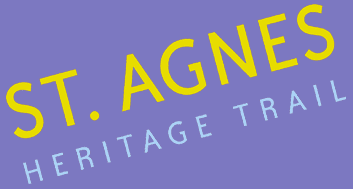
About St.Agnes
It is difficult to be suitably modest about St Agnes - whatever the season, it has
- Beaches
- Surfing
- Coastal and inland footpaths
- Visible reminders of a fascinating heritage
- Dramatic and panoramic views
- Friendly people
- Good pubs and restaurants
And it is
- an AONB (area of outstanding natural beauty)
- a part of Cornwall's Heritage Coast
- and contains SSSI (sites of special scientific interest)
...enjoyed whatever the season
Something of the essence of Cornwall, the landscape, people and history on which it has built its reputation is to be found here in the parish St. Agnes. Those involved in the production of these walks have sought to draw upon this blend of Cornishness to enrich the lives of locals and visitors and help them to enjoy and understand a little more about their landscape.
These are some of the defining features that we think make our Parish special
PEOPLE
Newcomers to the parish comment on the friendliness of its people and the huge variety of social events and local clubs, societies and charities.
MINING
Mining has shaped much of the St. Agnes landscape; many engine houses are still silhouetted against the skyline and miners' cottages cluster in tiny settlements surrounded by small fields that helped keep workers' families fed. Grander Georgian and Victorian buildings from the boom days of Cornish mining, when copper and tin were pre-eminent, indicate the way in which some of the wealth derived from mining speculation accumulated across the social scale. Spoil heaps or mine burrows litter the area, these and the occasional boundary stone serve as reminders of the abandoned industry.
BEACON
The Beacon dominates the area, giving St. Agnes Churchtown its original name of Bryanek. The barrows at its summit and the remnants of the Bolster Bank earthwork on its southern slope are evidence of early settlement in the parish. The views from the Beacon are stunning; on a clear day you can see from St. Ives to Trevose Head, Carn Brea to Caradon Hill. When local people return from their travels, the Beacon clearly marks the direction of 'home'.
SEA
With the sea bordering about a third of the parish its influence has been significant. Once it supported pilchard fishing and shipping, tin was 'streamed' on its beaches, and ships were built at Trevaunance Cove. Today the harbour is a ruin but the sea is still vital to the area. Much of the coastline is now managed by the National Trust, protecting the landscape and attracting holiday makers. Beaches are given over to bathers and surfers, the ships are gone, but one small boat, the Blue Peter IV inshore lifeboat is known countrywide by children who raised money for it via the television programme of the same name.
BOLSTER AND CUCKOO
Somewhere as old as St. Agnes predictably has Legends. Our most famous is that of Giant Bolster, who, in giving a token of his love for Saint Agnes, bled to death at Chapel Porth. Not to be forgotten either is the tale of the men of St. Agnes who tried to hedge in the Cuckoo so as to hold on to spring as long as possible.
FOOTPATHS AND NATURAL HISTORY
The parish is rich in wildlife. A Voluntary Marine Conservation Area has been established between Trevaunance Cove and Trevellas, safeguarding life underwater and on the seashore. Sea birds are prolific, and walks along the cliffs can often be rewarded by sightings of seals and very occasionally, dolphins and basking sharks. The flowers on the cliffs are particularly beautiful in April and May, and in the summer, heather and gorse provide a patchwork of purple and gold on the Beacon and cliff heathland.
 Walk 1 - St.Agnes Village Trail
Walk 1 - St.Agnes Village Trail Walk 2 - St Agnes Beacon
Walk 2 - St Agnes Beacon Walk 3 - Porthtowan, Banns Vale, Mount Hawke and Chapel Porth
Walk 3 - Porthtowan, Banns Vale, Mount Hawke and Chapel Porth Walk 4 - Wheal Rose, The Poldice Plateway and Mawla
Walk 4 - Wheal Rose, The Poldice Plateway and Mawla Walk 5 - Mount Hawke
Walk 5 - Mount Hawke Walk 6 - Mithian
Walk 6 - Mithian Walk 7 - Wheal Coates, Chapel Porth, Wheal Lawrence Valley and Goonvrea
Walk 7 - Wheal Coates, Chapel Porth, Wheal Lawrence Valley and Goonvrea Walk 8 - Water Lane, Wheal Butson and Jericho Valley
Walk 8 - Water Lane, Wheal Butson and Jericho Valley Walk 9 - Jericho Valley and Cross Coombe
Walk 9 - Jericho Valley and Cross Coombe Walk 10 - Blackwater
Walk 10 - Blackwater